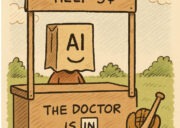
In the pursuit of increasingly intelligent models, AI agents have revolutionized the way we approach complex tasks, from assisting with medical diagnoses to generating creative code. However, as we rely on multi-step reasoning structures, a paradox begins to unfold: how is it that a system designed to “think” and reason can, at times, fail in such surprising and even hilarious ways? In this article, we explore the paradox of reasoning in AI, a fascinating dilemma that reveals why even intelligent agents can stumble in their logic.
The paradox of reasoning in ai: the illusion of omniscience
We have built systems that can beat the world chess champion or diagnose diseases with superhuman accuracy. It seems that ai is a manifestation of pure logic, an entity capable of reasoning infallibly. However, behind this facade of computational brilliance lies a paradox.
The paradox
The paradox is this: our ai agents, designed to process information, learn from it, and make “reasoned” decisions, often fail in scenarios that a small child would solve with astonishing ease. It’s not a matter of computing power, but of a deep gap in their understanding of the world and their ability to navigate its complexities.
Where does the reasoning chain break? why do agents trip?
To understand why our agents trip, we need to examine the key links in the reasoning process that, in current ai, are inherently fragile:
The blindness of context and lack of common sense
The problem: Ai operates based on the data it has been trained on. If it hasn’t been “taught” explicitly a piece of knowledge, it simply doesn’t exist for it. Think of an agent trained to recognize cats, but one that has never seen a wet cat. For us, it’s still a cat. For ai, it might be an alien creature.
The paradox in action: An ai agent might be an expert in medical diagnoses, but if asked to determine whether a patient needs an umbrella before going out, it would fail miserably unless trained with millions of examples of people using umbrellas on rainy days. There is no intrinsic understanding of the relationship between rain, umbrellas, and the need for protection.
Why it fails? Ai lacks what humans call “common sense,” that vast network of implicit knowledge about how the physical and social world works. It doesn’t infer, it just correlates.
The rigidity of symbolic logic vs. the ambiguity of the real world
The problem: For decades, AIreasoning has been based on symbolic logic: “if-then” rules, predicates, etc. This works wonderfully in well-defined domains (like a chessboard). However, the real world is inherently ambiguous, uncertain, and full of nuances.
The paradox in action: Imagine an ai agent designed to negotiate a contract. If programmed with rigid rules like “accept the offer if the price is X,” what happens when the other party offers a package that includes additional services but a slightly lower price than X? A human would evaluate the total value and intent. Ai, if not programmed for this flexibility, might reject the offer “reasonably” but “stupidly.”
Why it fails? Human logic isn’t purely binary. We operate with probabilistic inferences, heuristics, and an understanding that “rules” often have exceptions.
The “eliza” effect at scale
This is the phenomenon we observe in large language models (llms) and other advanced ai agents, where their ability to generate coherent and convincing responses can trick the user into believing the agent possesses a deeper understanding or intelligence than it actually does.
The problem: Large language models (llms) are masters of imitation. They can generate text that sounds remarkably coherent and “reasonable.” But this doesn’t mean they understand what they are saying. They’ve learned statistical patterns of language, not meaning.
The paradox in action: Ask an llm: “If I give you an apple and then give you another, how many apples do I have?” It will probably answer “two.” But if the question is: “If I give you an apple and then you give me one, how many apples do I have?” the llm might incorrectly answer “two” or “zero,” depending on how it processed similar patterns. It lacks a “mental model” of possession or transfer.
Why it fails? Current agents excel at the “syntax” of reasoning (the form), but often lack the “semantics” (the meaning). They repeat patterns without a deep understanding of the underlying world.
The problem of framing and combinatorial explosion
The problem: To reason about the world, an agent needs to consider all possible consequences of an action. However, the number of these consequences can be astronomical. This is the famous “framing problem.”
The paradox in action: A cleaning robot in a house needs to decide whether to move an object or clean it. If it moves the object, will something fall? Will it break? Will it block a door? Will it interrupt someone? The number of scenarios to consider is infinite, and the agent can’t process them all in real time.
Why it fails? Current agents lack the ability to intelligently filter out irrelevancies or focus on what truly matters in a given context, as humans do intuitively.
The “chain-of-thought” and its double-edged sword
One of the most popular approaches to giving ai agents reasoning skills is the chain-of-thought approach. The main idea is for the agent to follow a series of logical steps to reach a conclusion. This approach seeks to imitate the human method of breaking down problems into smaller parts.
However, just like a human who gets lost in endless digressions, ai can fall into reasoning traps. For example, if the agent relies on a chain of partial inferences, a single error can lead to completely incorrect conclusions.
Example – Failure in sequential reasoning:
pythonCopiadef evaluate_move(board, move):
# Step 1: Evaluate material gain with a simple calculation.
score = calculate_score(board, move)
# Step 2: Simulate the opponent's response.
response = simulate_response(board, move)
score -= response['danger']
# Step 3: Reason about the safety of the move.
if score > 0:
conclusion = "Acceptable Move"
else:
conclusion = "Risky Move"
return conclusion
# Helper functions simplified to illustrate the error
def calculate_score(board, move):
# Assume a fixed score without considering context
return 3
def simulate_response(board, move):
# Error in simulation: underestimates the opponent's response
return {'danger': 4}
# Example of use
board = "initial_state"
move = "e2e4"
result = evaluate_move(board, move)
print("Move evaluation:", result)
In this example, the agent uses three sequential steps to evaluate a move. The failure originates from the simulate_response function, which doesn’t capture the real complexity of the game. As a result, the reasoning chain breaks, leading to an incorrect classification of the move. This type of failure reflects the paradox: the same structure designed to improve reasoning can, if not handled with precision, induce cumulative errors.
The importance of context and uncertainty
One of the fundamental reasons behind these errors is the inherent difficulty of capturing the full context at each step of reasoning. While a human can feed back their reasoning based on intuitions and previous experiences, an ai agent operates on predefined data and rules. In scenarios with high uncertainty or where multiple paths are plausible, ai might choose a faulty path.
Example – Inadequate handling of uncertainty:
pythonCopiadef reasoning_with_uncertainty(data):
# Step 1: Interpret the initial data
if "inconsistency" in data:
interpretation = "Ambiguous"
else:
interpretation = "Clear"
# Step 2: Take action based on the interpretation
if interpretation == "Clear":
action = "Execute Task"
else:
# Error: does not handle ambiguous cases properly
action = "Execute with risk"
return action
# Example of use with ambiguous data
input_data = {"inconsistency": True, "value": 42}
resulting_action = reasoning_with_uncertainty(input_data)
print("Suggested action:", resulting_action)
In this block, by not having robust strategies for ambiguous cases, the agent ends up making hasty decisions. The inability to integrate feedback to correct the inference process leads to an error in the final action, highlighting the importance of dynamically handling context in artificial reasoning processes.
Recursive reasoning paradoxes
Another interesting aspect is when ai faces problems that require recursive reasoning. These are cases where the solution depends on subproblems, each requiring continuous reasoning. The recursive nature can multiply errors if any of these levels introduces imprecision.
Imagine an agent tasked with solving a complex math problem using a recursive approach. The specification of each new subproblem must be precise, and any ambiguity can be lost in the translation from one level to another. Even a small failure in interpretation can cause the reasoning to become self-fragile, making the whole process collapse.
Example – Defective recursive reasoning:
pythonCopiadef solve_problem(n):
# Base case
if n == 0:
return 1
# Recursive case
# Error: the operation is not suitable for the given problem
return n * solve_problem(n - 1) + 1
# Example to calculate modified factorial of a number
result = solve_problem(5)
print("Recursive result:", result)
Here, a subtle modification in the factorial algorithm (adding 1 at each step) illustrates how recursion can propagate errors. The paradox is clear: structures designed to simplify problems can, with slight imperfections, produce results that increase uncertainty and error.
Beyond the paradox: how do we overcome the stumbling blocks?
Recognizing the paradox is the first step. Overcoming it requires a fundamental shift in how we design and train our ai agents. Some promising avenues include:
- Integration of common sense knowledge: Whether through human-curated knowledge bases or by learning richer and more abstract representations of the world, this is one of the current biggest challenges.
- Hybrid symbolic and neural learning: Combining the robustness of symbolic logic with the flexibility of deep learning. Imagine agents that can learn patterns (neural) and then explain them and reason about them with rules (symbolic).
- Modeling uncertainty and probabilistic reasoning: Instead of operating with absolute certainties, agents should learn to reason under uncertainty, assigning probabilities to different outcomes and acting accordingly.
- Causal reasoning vs. correlational reasoning: Moving from merely finding correlations in data to understanding cause-and-effect relationships. This is crucial for truly intelligent reasoning.
- Active and interactive learning: Allowing agents to ask questions when they don’t understand, seek new information, and learn through interaction with humans and their environment.
Lessons learned
The paradox of reasoning in ai teaches us several essential lessons:
- Validation and verification: Every step in the reasoning chain should be rigorously validated. Integrating uncertainty assessments and contexts is vital to avoid cumulative errors.
- Dynamic feedback: Implementing real-time feedback mechanisms allows the agent to correct its course while reasoning, reducing the possibility of accumulating irreversible errors.
- Modular and robust design: Breaking down complex problems into independent but interconnected modules helps mitigate error propagation, allowing more precise adjustments in the deficient parts of reasoning.
The future of ai lies in developing systems that are not only capable of processing information but also of recognizing their own limitations and correcting them in the process. The reasoning paradox is, at its core, a reminder that even ai must learn to be aware—within its capabilities—of its own mistakes in order to evolve.




